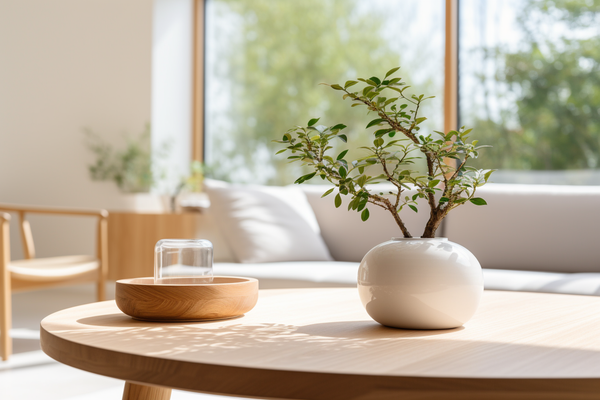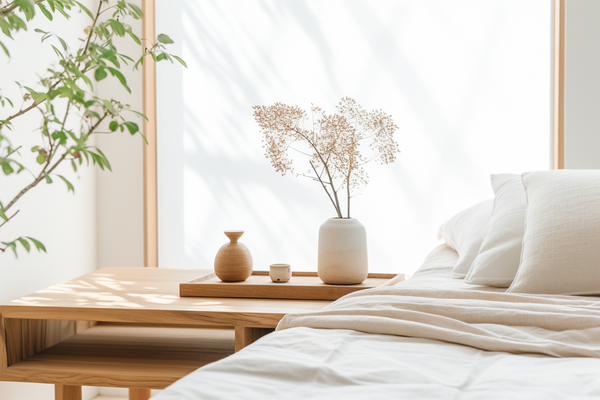Ever felt a wave of serenity envelop you the moment you enter a room? That's probably because you've just walked into a Zen-inspired sanctuary. Zen-inspired decor is not just a fad; it's a way of life that can infuse your home with tranquility.
I remember transforming my own chaotic living room into a Zen space, and the sense of peace it brought was almost immediate.
In the hustle and bustle of modern life, who wouldn't want their own little haven of peace? Stick to the end as we're about to explore the enriching realm of Zen-inspired interior design.
Historical Background of Zen in Design

It's deeply rooted in Zen Buddhism, a spiritual practice that originated in China and later made its way to Japan around the 12th century.
For centuries, Japanese designers have been weaving Zen principles into their work. Imagine a traditional Japanese home.
What comes to mind? Tatami mats, sliding doors, and a deep connection with nature, right? These elements are not just aesthetic choices; they are deeply influenced by Zen principles like simplicity and harmony.
So, why does this matter to you? Well, understanding the history and principles of Zen can help you appreciate the depth and thoughtfulness that goes into Zen-inspired design.
Core Principles of Zen-inspired Interior Design
Simplicity
In today's world, where we're constantly bombarded by information, ads, and an endless array of "stuff," the Zen principle of simplicity is a welcome relief.
Imagine a room stripped down to its essentials: a comfortable chair, a soothing painting, and perhaps a potted plant.
I remember when I decluttered my own workspace, leaving only the bare necessities. The sense of clarity and focus I gained was remarkable.
In Zen design, simplicity isn't about deprivation; it's about creating space for your thoughts, dreams, and, most importantly, peace of mind.
Nature
Nature plays a pivotal role in Zen-inspired design. Picture the calming sound of a stream or the tranquil sight of a lush garden.
I once added a small water feature to my living room, and the soothing sound instantly elevated the space. These elements aren't just decorative; they're fundamental to the Zen aesthetic.
Incorporating natural materials like wood, stone, and water can turn your home into a true sanctuary. Even a simple bamboo plant on your coffee table can make a significant impact.
Harmony and Balance
Ever walked into a room and felt something was amiss, but couldn't quite pinpoint what it was? It's likely that the room lacked harmony and balance, the core tenets of Zen design.
Think of symmetrical arrangements, harmonious color schemes, and well-placed lighting. It's akin to a beautifully composed song where each note has its place, creating a balanced melody for your life.
Key Elements in Zen-inspired Interior Design

Open Spaces
Open spaces in Zen design aren't just about square footage; it's about emotional freedom. For me, transforming my cluttered living room into an open, airy space was like lifting a mental fog.
These open spaces act as blank canvases for your imagination, inviting you to be fully present and letting your mind wander without tripping over distractions.
Minimalism
If Zen design had a best friend, it would be minimalism. They go hand in hand like peanut butter and jelly.
Minimalism in Zen design is all about saying more with less. It's about choosing quality over quantity. Imagine a room with just a few pieces of furniture, each serving a specific purpose. No clutter, no distractions. Just a space that invites you to relax and breathe easy.
Natural Light
I used to underestimate the transformative power of natural light until I swapped my heavy drapes for sheer curtains. The way the sun's rays filtered into the room was akin to watching a live painting unfold throughout the day. Soft play of light and shadow can make any room feel alive.
How Zen-inspired Design Differs from Other Styles

You might be asking yourself, "What sets Zen-inspired design apart from other popular styles like Scandinavian or Bohemian?" Excellent question!
While each design style has its unique allure, think of Zen design as the wise elder in the room. It goes beyond mere aesthetics to create a space that nourishes your soul.
When comparing Zen to other styles, you'll find some interesting differences. For instance, both Zen and Scandinavian designs appreciate simplicity, but where Scandinavian zeroes in on coziness, Zen is all about spiritual tranquility.
On the other hand, Bohemian design thrives on vibrant colors and an eclectic atmosphere, which stands in stark contrast to Zen's subdued hues and balanced layouts.
And let's not forget Industrial design, which is raw and edgy, a far cry from Zen's soft and harmonious nature.
Practical Tips for Implementing Zen-inspired Interior Design

Here are some practical tips to help you bring Zen into your home without breaking the bank or your back!
1. Choosing the Right Colors
In Zen design, color is more than just eye candy; it sets the mood. Think soft, muted tones like beige, light gray, and pastel greens. These colors are like a visual lullaby that helps you unwind.
2. Furniture Selection
Less is more. Choose pieces that are functional and aesthetically pleasing but without the extra frills. For example, a simple wooden chair is preferable over an ornate, upholstered one.
And hey, if you're looking for pots to add a touch of nature, check out our Kanso planters. They're not just eco-friendly; they're also perfectly aligned with Zen principles.
3. Incorporating Nature
Plants are a Zen design staple, but you can go beyond the usual potted fern. How about a mini Zen garden on your coffee table? Or a small indoor fountain to mimic the sound of flowing water? The sky's the limit!
4. Mindful Decor
Think mindful, not mind-full. Choose items that have meaning to you or bring you joy. A single piece of artwork that resonates with you is better than a wall full of random decorations.
5. Textures and Fabrics
Soft, natural fabrics like cotton and linen can add a tactile dimension to your Zen space. Think cozy throw blankets or textured rugs that invite you to kick off your shoes and relax. It's not just décor; it's a form of self-care.
6. Lighting Choices
Opt for soft, ambient lighting over harsh, direct lights. Floor lamps with dimmer switches or table lamps with fabric shades can create a soothing atmosphere. Those first few moments when we dim the lights in the evening? It's like the room lets out a sigh of relief, and so do we.
Zen-inspired Interior Design Ideas for Beginners

The Tranquil Home Office
When it comes to crafting a tranquil workspace, a desk with clean lines and a neutral color becomes the unsung hero.
But don't stop there; organizers or trays can be your best friends in keeping that clutter in check. Imagine having a small bamboo plant in a Kanso planter sitting beside you. This isn't just a plant; it's your companion reminding you to breathe.
And if you've never worked to the soundtrack of a tabletop fountain, you're in for a treat—the calming backdrop it creates is unlike any Spotify playlist you'll find.
The Harmonious Living Room
In your living room, aim for harmony. Rearrange your furniture to open up space; think clear pathways that invite you to walk freely.
Your color choices set the emotional tone of the room. A palette of beiges, whites, and light grays doesn't just look good; it feels good. Now, about that natural light: sheer curtains or even a skylight can elevate your space from just a room to an oasis.
The Balanced Bedroom
The bedroom should be your ultimate retreat, a place that nurtures your soul as much as it does your body. A low bed isn't just a style choice; it's an invitation to humility and simplicity.
When it comes to lighting, we're talking about ambiance. Whether you opt for bedside lamps with dimmer switches or install other sources of soft, ambient lighting, you're not just decorating—you're creating a mood.
As for the color palette, go for muted tones like pastel blues or light grays. Your walls, your bedding, and even your decor contribute to a soothing backdrop for restorative sleep.
Conclusion
From choosing the right colors and furniture to incorporating nature and mindful decor, these tips are your roadmap to a more peaceful and balanced life. And remember, Zen design is not just about following a set of rules; it's about creating a space that reflects your inner self. So go ahead, give your home that Zen makeover it deserves. You won't regret it!
References
Lee, R. (2021). The Influence of zen on contemporary aesthetics in decorative arts and design. Digital Commons @ SIA. https://digitalcommons.sia.edu/stu_theses/106/
Lieberman, F. (n.d.). Zen buddhism and its relationship to elements of eastern and western arts. http://artsites.ucsc.edu/faculty/lieberman/zen.html
Zen Spaces and Neon Places. (n.d.). https://china.usc.edu/sites/default/files/3a.%20A%20View%20from%20the%20Zen%20Shoin.pdfFrom Waste to Resource
Our efforts and commitment to waste reduction and sustainability begin with our production process.
Plastic and agriculture wastes are repurposed and utilized through innovative transformation into a biodegradable composite material.

